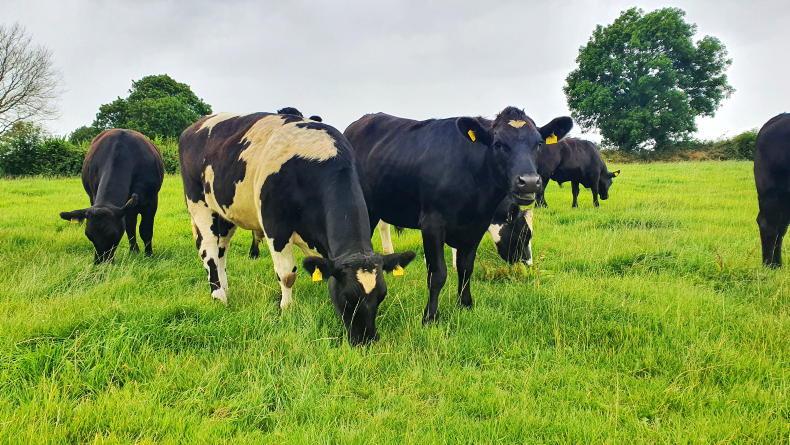Getting grass right for dairy-beef systems is one of the more difficult aspects but without doubt is the most important in order to have a profitable enterprise.
On the demonstration farm, the demand for grass is very low in spring as the heaviest group of cattle are only 350kg.
The calves are not out at grass until May and, even then, their demand is very low. This is where having a dairy-beef enterprise running alongside another livestock system can help as it evens out the demand for grass at different times of the year.
On the demo farm, it means that grass can get ahead of stock in April if not carefully managed.
To overcome this, a large proportion of the farm is closed for an early cut of silage while on the grazing platform a number of paddocks are usually cut by mid-May.
As the year progresses, the demand for grass increases. Currently, there is a daily demand of 44kgDM/ha.
In normal growing conditions, there is no issue growing this much grass. However, a dry June and July has seen growth struggle and grass supply on the farm is under pressure.
Grazing targets
The target is for stock to enter covers of 1,400kg DM/ha to 1,600kg DM/ha (10cm to 10.5cm) consistently.
Weekly grass measuring has helped to achieve this and allows the farm to make grazing decisions before issues arise.
In 2021, the farm grew 11.7tDM/ha on average across the farm. There are 40 permanent paddocks on the farm which allow great flexibility when it comes to grazing.
Each of these can be sub-divided, where necessary.
Group size
Having sufficient grazing pressure when you enter a paddock is important as it helps keep stock moving every few days. Where most farms go wrong with grassland management is offering too large an area for grazing or not having a big enough group for the paddock size.

Meal feeding at grass on the Thrive demo farm, August 2021.
Where stock are in a paddock for five days trying to achieve a 4cm post-grazing sward height, liveweight gains are going to suffer.
The post-grazing sward height on the demo farm would be greater than 4cm but this is aiding animal performance.
It does mean a round of topping is necessary at some stage during the season.
However, due to the fact that many of the paddocks will be cut for silage at some point throughout the year means topping is kept to a minimum.
Liveweight gain for the yearling cattle is currently 1.15kg/day since turnout for the bullocks and 0.95kg.day for the heifers. The gap in liveweight gain is greater between the two groups this year compared to recent years and the reason for this is unknown.
Getting grass right for dairy-beef systems is one of the more difficult aspects but without doubt is the most important in order to have a profitable enterprise.
On the demonstration farm, the demand for grass is very low in spring as the heaviest group of cattle are only 350kg.
The calves are not out at grass until May and, even then, their demand is very low. This is where having a dairy-beef enterprise running alongside another livestock system can help as it evens out the demand for grass at different times of the year.
On the demo farm, it means that grass can get ahead of stock in April if not carefully managed.
To overcome this, a large proportion of the farm is closed for an early cut of silage while on the grazing platform a number of paddocks are usually cut by mid-May.
As the year progresses, the demand for grass increases. Currently, there is a daily demand of 44kgDM/ha.
In normal growing conditions, there is no issue growing this much grass. However, a dry June and July has seen growth struggle and grass supply on the farm is under pressure.
Grazing targets
The target is for stock to enter covers of 1,400kg DM/ha to 1,600kg DM/ha (10cm to 10.5cm) consistently.
Weekly grass measuring has helped to achieve this and allows the farm to make grazing decisions before issues arise.
In 2021, the farm grew 11.7tDM/ha on average across the farm. There are 40 permanent paddocks on the farm which allow great flexibility when it comes to grazing.
Each of these can be sub-divided, where necessary.
Group size
Having sufficient grazing pressure when you enter a paddock is important as it helps keep stock moving every few days. Where most farms go wrong with grassland management is offering too large an area for grazing or not having a big enough group for the paddock size.

Meal feeding at grass on the Thrive demo farm, August 2021.
Where stock are in a paddock for five days trying to achieve a 4cm post-grazing sward height, liveweight gains are going to suffer.
The post-grazing sward height on the demo farm would be greater than 4cm but this is aiding animal performance.
It does mean a round of topping is necessary at some stage during the season.
However, due to the fact that many of the paddocks will be cut for silage at some point throughout the year means topping is kept to a minimum.
Liveweight gain for the yearling cattle is currently 1.15kg/day since turnout for the bullocks and 0.95kg.day for the heifers. The gap in liveweight gain is greater between the two groups this year compared to recent years and the reason for this is unknown.







 This is a subscriber-only article
This is a subscriber-only article











SHARING OPTIONS: